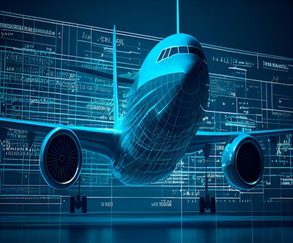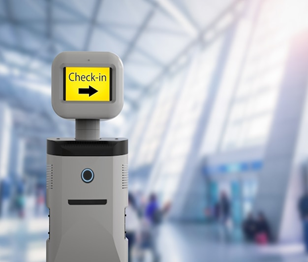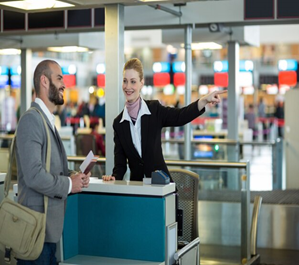AI in the Aviation Industry: A Revolution in the Way We Fly
Artificial Intelligence (AI) is rapidly developing, and becoming much more accessible and affordable. AI and Machine Learning (ML) are evolving at a brisk pace, influencing all the major industries including aviation. The aviation industry has taken huge feats owing to the advancement of technology. This has made air travel safer and more efficient. Even the authorities are taking all the applicable measures to implement innovations within the industry with the sole intention of improving sustainability. One such measure is the development of smarter airports.

The ultimate goal of the development of smarter airports is to introduce a document-free and touchless airport experience that is based on global identity management and tracking. In essence, passengers will be able to identify themselves at intermediate checkpoints across the airport through effective, resilient biometric recognition services. Systems that enable the vision are based on the ideas of RFID technology (that can be used for luggage tracking or security checks), touchless fingerprinting, and gestures and face recognition. This multimodal biometric recognition system would be evolving around high-definition cameras, which fuse different biometric modalities while improving prediction rates and achieving significantly increased robustness. Furthermore, mobile phones can also be used to provide support in verifying and guiding passengers from the point of entry at the airport to the boarding gate.
Applications of AI in the Aviation Industry
The first and foremost application of AI can be seen in the management of air traffic. Technologies such as ML can be used in the advancement of automation and computing power of data analytics models to enhance the management of ever-increasing air traffic. Research is also being conducted for the development of Unmanned Aircraft systems (UAS) and their associated technologies. These systems will have an impact on self-separation, information management, data sharing, and decision-making to help in the mitigation of complexities resulting from the expected increase in airspace users.
The availability of vast amounts of data requires adequate methodology and technology to streamline the data to action. AI can address this for the aviation industry by advancing its business intelligence in terms of practices including marketing and sales, distribution, pricing strategies, customer loyalty, network optimization, and fleet management. Additionally, ML has a high potential to assist the direct sales channels. Furthermore, real-time insights into customer behavior pre-sales and post-sales can assist tactical changes. Blending of different data sources is a great opportunity to identify patterns and use these to better analyze data and predict future behavior.

The use of robotics driven by AI has the potential to streamline ground handling processes at the airport either through improvement of the process or the ability to do it significantly faster. These can include processes such as safety checks, aircraft movement operations, pushback, towing, aircraft turnaround operations, fueling, potable water loading and draining, lavatory servicing, catering, aircraft loading and unloading, de-icing and anti-icing, ground transportation on the ramp, baggage, cargo, and mail.
AI systems can prove to be a great addition to the airport security system. Airport security is and will always be a high-priority task. However, guaranteeing security shouldn’t compromise the experience of the passengers. Ideally, it should be as invisible as possible. ML can potentially unlock concepts that can facilitate ways to increase security while improving the passenger experience. Threats in the majority of times go hand in hand with anomalies in patterns. AI can consume vast amounts of data both historically as well as in real-time and enable the detection of such anomalies.
Massive advances are being made in deep learning over images that have led to the efficient detection and identification of people and their gestures based on high-definition camera systems. These camera systems could also be used for contactless scanning of passports and health screening. Another promising technology is voice-based recognition, however, it is still in its infancy and the required reference profile data are not available to airports.
There are numerous open-source machine learning frameworks such as Tensorflow21 and Scikit-learn22 which accelerate the development of this overarching technology in the aviation industry. For instance, their image recognition feature could help in recognizing and identifying people alongside objects in certain images. It could also help in understanding the context alongside the content of the image. Airbus has taken initiatives to flight autonomy under their Autonomous Taxi, Takeoff, and Landing (ATTOL) project. This ML process enables the algorithm to identify similar objects through computer vision in future events and act accordingly. Hence the computer identifies runway centerline, thresholds, and other markings to take actions during taxi, take off, and landing. While deep learning fine-tunes the algorithms of vision-based automated systems, Natural Language Processing (NLP) is used to build algorithms for virtual assistance. Piolets get the chance to command the airplane through voice commands and receive feedback.
The human-machine interface is extremely critical in minimizing errors in the aviation industry as studies suggest that, human errors contribute to more than 70.0% of accidents. Sharing a portion of the workload with an AI computer will reduce the stress and fatigue in pilots, especially within the critical phases of the flight including takeoff, initial climb, approach, and landing. Apart from the improvement of human-machine interaction, AI can eliminate lapses in technology as its algorithms become advanced with machine learning.
Lastly, AI can also aid predictive maintenance. Enormous amounts of data on aircraft utilization, maintenance, delays, and many more are pumped into the AI’s ML algorithms and the airlines receive predictions in return, that are worth millions of dollars when converted into flight hours. Thanks to the predictive maintenance backed by AI, unprecedented Aircraft On Ground (AOG) situations can be identified to eliminate flight delays and cancellations.
Challenges Faced by AI in the Aviation Industry
The first and foremost challenge to bring AI to the aviation industry is establishing public trust. According to research, nearly 40.0% of the general population have a fear of flying in various degrees while a population of 2.5% is at a clinical level that is they completely avoid flying or do it with extreme stress. Knowing that a computer does the flying, more people will join the list. Thus, various safety agencies are taking conscious steps to deal with the issue. The first addition to the list is the development of a proper certification scheme for AI. It is followed by defining proper standards, protocols, and methods to develop and establish AI models in aviation. Besides, the incorporation of AI in aviation should be in line with certain ethical dimensions.
Many developers and companies including both that are well-established or start-ups are studying different use cases and ways in which AI can be used to extract benefits. The developments resulting from these researches can be of threat, in terms of product cannibalization, legacy product disruption, lower perceived product value, and routine and repetitive jobs.
Withal, the design and construction of a novel aircraft type come with tremendous expenses. It not only includes the manufacturing cost, but also research cost, technology development and execution cost, and at times the cost of development of all new infrastructure. At such times even a minute misjudgment could lead to huge losses. For instance, Airbus spent approximately $25.0 billion to develop the A380 which was the biggest investment the manufacturer had ever made. While the design and production process led to many novel and long-lasting technologies, the overall project of the A380 was ultimately coined as a failure. One of the major reasons was that the airlines overestimated their ability to fill more than 500 seats on connections that are being served multiple times a day, together with severe financial and logistic challenges for airports, as more than $1.0 billion was spent on the Dubai International Airport for turning it into A380-ready.
Another major limitation is evident in the use of RFID technology. There is a need for a physical handover process of the RFID tags. The major goal of using RFID is to eliminate contact among passengers and airport staff. However, where RFID redefines luggage tracking it is still ineffective for passenger tracking. Additionally, issues are being registered in the touchless fingerprinting technology. Traditional fingerprint detection comes with several problems, such as mapping a 3D finger to a 2D plane, which introduces distortions, noise, and inconsistencies in the captured fingerprint image. The dilemma is even the touchless fingerprinting technology is facing challenges in terms of incompatibility with established touch-based fingerprinting and the problem of detecting fakes reliably.

However, it should be noted that a human workforce will never be fully eliminated from airport processing, since there is always a need for a backup in case the technology fails, for instance, physical presence or at least telepresence. Similarly, highly-automatic processing still requires physical security backups in case some passengers are not cooperative. In a nutshell, the actual passenger handling and guidance at touchless airports and the operation of UAS will be done by machines and technology, but humans will have to supervise the correct execution.